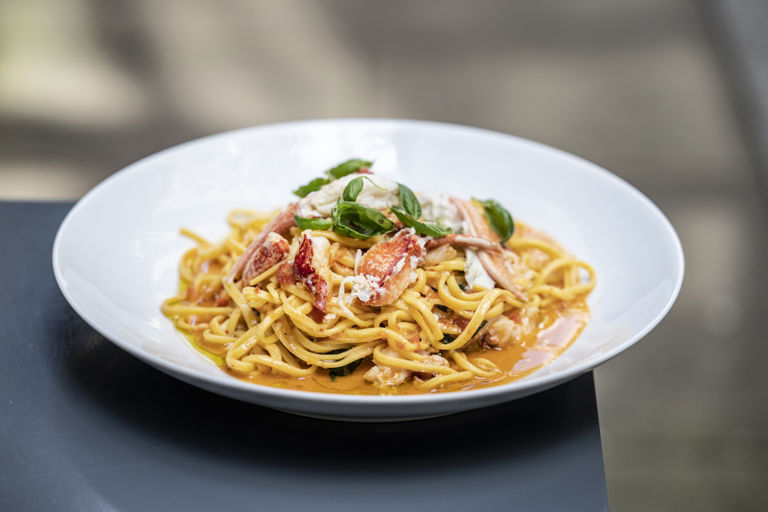Lobster linguine with genovese basil

- medium
- 4
- 2 hours plus resting time
Homemade pasta is a joy to create, requiring just a handful of basic ingredients (and a pasta machine, of course!). Chef Matt Beardmore creates homemade linguine to be tossed with a luxurious lobster sauce, given added fragrance thanks to plenty of basil. Matt uses a chitarra cutter to create ribbons of pasta, but you could also use a sharp knife if you don't have one of these at home.
Ingredients
Metric
Imperial
Stock
- 1 shallot, chopped
- 3 bay leaves
- 1 celery stick, finely sliced
- 12 black peppercorns
Sauce
- 1 lobster, weighing approx. 800g–1kg
- 2 San Marzano tomatoes
- 2 garlic cloves
- extra virgin olive oil
- 50g of butter
- 1/2 bunch of basil
- 1 pinch of dried chilli flakes, or to taste
- 1/2 lemon, juiced
- sea salt
Equipment
- Food processor
- Pasta machine
- Chitarra pasta cutter
Method
Place the lobster in the freezer for at least 15 minutes before cooking to put it to sleep – while you wait, bring a large pan of salted water to the boil. After this time, remove it from the freezer and place on a chopping board. Place a knife onto the cross where the head meets the body with the blade facing towards the head. Insert the knife into the head to kill it instantly
- 1 lobster, weighing approx. 800g–1kg
Cook the lobster in salted boiling water for 8-10 minutes then drain and immediately chill down in a bowl of iced water. Once chilled, remove the claws then slice the lobster lengthwise down the centre. Remove the stomach sack and discard, then scrape out the brown meat into a bowl
Gently remove the tail and cut into 4–5 pieces. Cut or break the claws and arms into sections at each joint and gently remove the meat from the arms using a cocktail stick. Crack open the claw and remove the meat, in one piece if possible. Add this to the white tail meat
Roughly break or chop up the shell and add to a hot pan with a splash of oil. Fry for a few minutes, then add the shallot, bay, celery and peppercorns and cook for a further minute. Add water to just cover the shells and bring to the boil. Turn down the heat and simmer for 1 hour until you have a flavoursome stock. The liquid should reduce in this time which will intensify the flavour. Strain through a fine sieve and set aside
- 1 shallot, chopped
- 3 bay leaves
- 1 celery stick, finely sliced
- 12 black peppercorns
As the stock simmers, make the pasta dough. Place the flour in a food processor. Combine the whole egg and egg yolk and, with the motor running, slowly add to the flour until it has a crumb-like consistency. Tip into a bowl then bring together into a dough with your hands. Wrap in cling film and rest in the fridge for 1 hour
Next, make the sauce. Use a paring knife to remove the cores from the tomatoes and cut a small cross in the bottoms. Blanch in boiling water for about 20 seconds or until the skin starts to peel away from the tomatoes. Refresh in iced water then peel and roughly chop
Place a saucepan over a medium heat and add a generous glug of oil. Finely slice the garlic and gently fry for 2-3 minutes until soft and translucent but not coloured. Add the chopped tomatoes and a pinch of salt and gently cook for about 30 minutes until you have a thick sauce. Taste, season and set aside
Once the pasta dough has rested, unwrap it – you will probably only need about half the dough for this recipe, so the remainder can be rewrapped and reserved in the fridge or freezer. Roll out the dough so it is thin enough to easily go through a pasta machine at its thickest setting – about 1–2 cm. Roll through the machine 3 or 4 times, reducing the thickness one increment at a time. Fold both ends into the centre then fold in half. Roll out with a rolling pin again to about 1-2cm. Rotate 90 degrees and repeat this process
Now begin to pass the dough through the machine, reducing the thickness an increment at a time until it is 1-2mm thick. Cut into equal sheets approximately 30cm long. Using a chitarra, a linguine attachment or a sharp knife, cut the pasta into long, thin ribbons. Place on a tray dusted with semolina and set aside
Take the pan of tomato sauce and add a good ladle of the lobster stock, the brown lobster meat, half the butter and a good pinch of dried chilli. Gently stir and heat through until the butter melts. Keep warm over a very low heat
- 25g of butter
- 1 pinch of dried chilli flakes, or to taste
In another small pan add the whole lobster claw meat with a splash of stock and a the rest of the butter. Very gently heat through and keep warm
- 25g of butter
Cook the pasta in salted boiling water for 1–2 minutes. Once the pasta is cooked add to the sauce along with the tail meat and most of the basil and begin to toss vigorously over a high heat. The sauce should thicken and emulsify so it coats the pasta evenly. If it looks a little thick add a splash more stock or some pasta cooking water. If it looks a little thin – keep tossing!
- 1/2 bunch of basil
Get in touch
Please sign in or register to send a comment to Great British Chefs.


